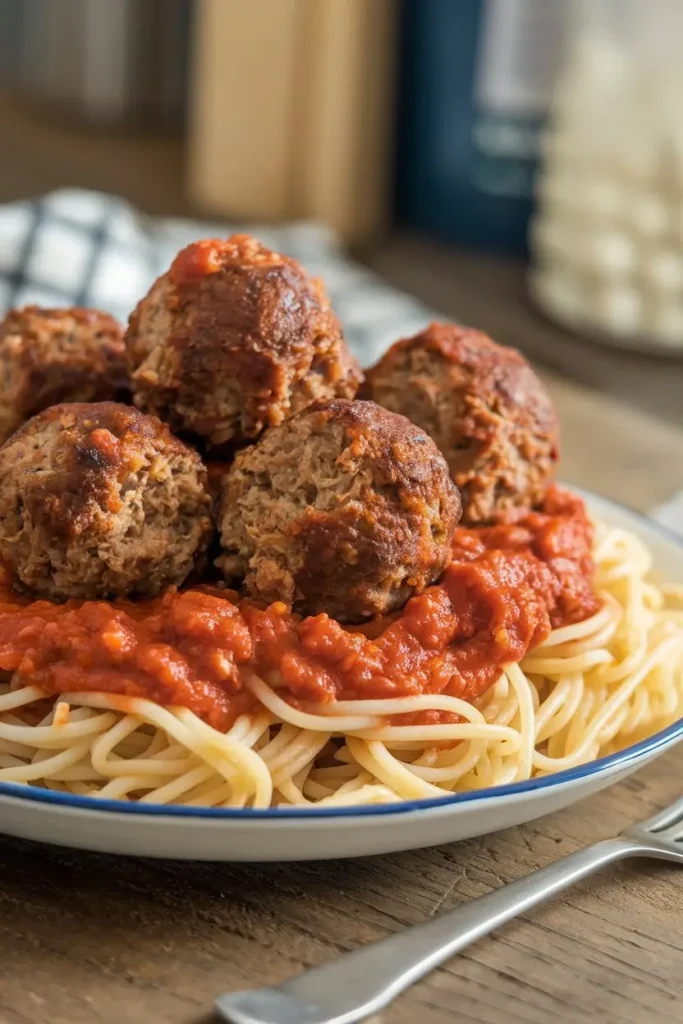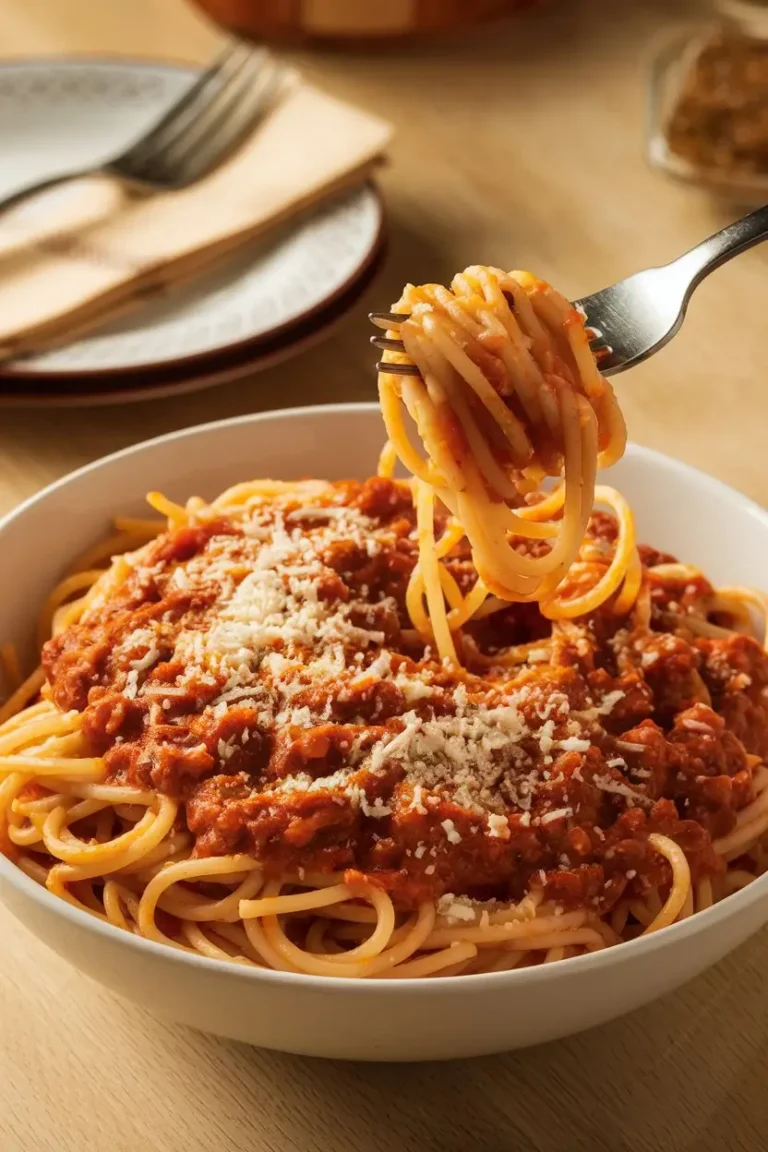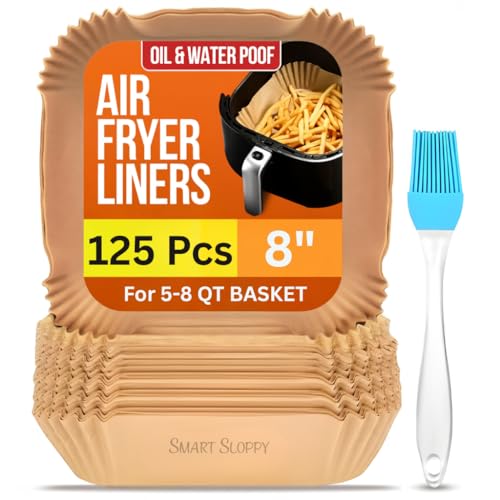If the average American eats around 20 pounds of pasta each year, why does grandma’s spaghetti taste better than almost anything you can order out? The answer isn’t just nostalgia. It is a set of repeatable techniques that coax deep flavor from simple ingredients, and a few small choices that change everything.
Why Grandma’s Spaghetti Still Wins: Recipe, Nutrition, and Smart Swaps
Introduction
That first forkful of grandma’s spaghetti is all about balance: bright tomatoes, savory meat, a whisper of garlic, and noodles that still have a little bite. For many families, this classic spaghetti dinner shows up on weeknights and at big Sunday tables alike. The good news is that you can recreate it with consistent results. This guide breaks down the best method for grandma’s spaghetti, blending tested techniques with practical timing, nutrition details, and options for different diets.
You will find tips that seasoned cooks use without thinking, like when to salt, how long to simmer, and why finishing pasta in the sauce matters. You will also get data-backed time estimates, a nutrition table, and healthy swaps. Whether you cook for two or for a crowd, these steps turn a humble pantry lineup into a dish that feels as special as grandma’s spaghetti every time.
Ingredients for Grandma’s Spaghetti
A short list, big flavor. Aim for quality tomatoes and good olive oil, then let patience take over.
Sauce and pasta:
- 2 tablespoons extra-virgin olive oil
- 1 medium yellow onion, finely diced
- 4 cloves garlic, thinly sliced
- 1 stalk celery and 1 small carrot, finely minced for soffritto (optional but recommended)
- 1 pound ground beef 80-20 or a 50-50 mix of beef and pork
- 1 teaspoon kosher salt, plus more to taste
- 1 teaspoon freshly ground black pepper
- 1 teaspoon dried oregano
- 1 teaspoon dried basil or 6 leaves fresh, torn
- 1 teaspoon sugar or 1 grated carrot to balance acidity
- 2 tablespoons tomato paste
- 1 cup dry red wine or low-sodium beef broth
- 1 can 28 ounces crushed tomatoes or whole peeled San Marzano tomatoes hand-crushed
- 1 bay leaf
- 1 pinch red pepper flakes
- 1 pound spaghetti
- 1 cup reserved starchy pasta water
- 2 tablespoons unsalted butter or a drizzle of olive oil to finish
- 1 cup finely grated Parmigiano Reggiano or Pecorino Romano
- Fresh basil or flat-leaf parsley, chopped, for garnish
Smart substitutions:
- Meat: Swap ground turkey or chicken for leaner protein. For a vegetarian ragù, use a 50-50 mix of finely chopped mushrooms and lentils.
- Tomatoes: If acid bothers you, choose fire-roasted or low-acid tomatoes and reduce sugar.
- Wine: Replace with broth plus 1 teaspoon balsamic vinegar.
- Pasta: Whole wheat, brown rice, chickpea, or gluten-free spaghetti work well. Adjust cooking time as needed.
- Dairy: Skip butter and use olive oil. Choose a plant-based hard cheese alternative or nutritional yeast.
Flavor boosters that make a difference:
- A Parmesan rind simmered in the sauce
- A splash of milk at the end for a silkier finish
- A small anchovy fillet melted into the oil with the garlic for deeper savoriness

Timing for Grandma’s Spaghetti
From chopping to plating, you can sit down to a standout plate without losing your afternoon.
- Prep time: 15 minutes
- Active cooking: 30 minutes
- Simmer time: 40 minutes
- Pasta cooking and finishing: 10 minutes
- Total time: About 95 minutes, which is roughly 20 to 30 percent quicker than many long-simmer sauces that often run 2 to 2.5 hours
Tip: If you’re short on time, simmer 25 minutes and finish with an extra tablespoon of butter for body. If you have the time, extend the simmer to 75 minutes for a deeper, rounder flavor.
Step-by-Step Instructions
Step 1: Build the flavor base
Warm the olive oil in a heavy pot over medium heat. Add onion, celery, and carrot with a pinch of salt. Stir until translucent and sweet, about 8 to 10 minutes. Add garlic and red pepper flakes. Cook 1 minute until fragrant. This slow start sets the tone for everything that follows.
Tip: Salt the vegetables early. It pulls moisture out and speeds up softening without browning too fast.
Step 2: Brown the meat for a fond you can taste
Add the ground beef or beef-pork mix. Increase heat slightly. Season with salt and pepper. Break up the meat and let it sit long enough to brown on contact, then stir. You want browned bits at the bottom of the pot. Cook until no longer pink and nicely caramelized at the edges.
Tip: If there is excess fat, spoon off a little, but leave some behind for flavor. Aim for a glossy sheen, not a greasy pool.
Step 3: Wake up the tomatoes
Stir in tomato paste and cook 2 minutes until rust-colored and sticky. Pour in red wine to deglaze, scraping up every browned bit. Let it reduce by half. Add crushed tomatoes, oregano, bay leaf, and sugar or grated carrot. Stir and bring to a gentle boil.
Tip: Tomato paste turns sweeter and more complex when it hits the hot pan before liquid. That short toasting step is gold.
Step 4: Simmer low and quiet
Drop heat to low. Partially cover and simmer 40 to 60 minutes, stirring every 10 minutes. If the sauce gets too tight, add a splash of water. Adjust salt and pepper near the end. Add fresh basil or a few torn leaves in the last 5 minutes to preserve their aroma.
What you’re watching for: a sauce that has thickened enough to coat a spoon, bright acidity smoothed out by time, and meat that is tender, not crumbly.
Step 5: Boil spaghetti with intent
Bring a large pot of water to a rolling boil. Salt generously. A good rule is 1 tablespoon kosher salt per 4 quarts water. Cook spaghetti until it is just shy of al dente. Reserve 1 cup of the starchy water.
Data note: Pasta water typically holds about 1 to 2 percent starch, depending on the pasta and time. That starch helps sauce cling and emulsify.
Step 6: Marry pasta and sauce
Transfer drained spaghetti directly to the sauce pot. Add 1/2 cup pasta water and toss over medium heat for 1 to 2 minutes. Add butter or a drizzle of olive oil and half the cheese. Toss again until glossy and well coated. If it seems tight, add a bit more pasta water.
Tip: Finishing pasta in the sauce is the move that makes restaurant plates taste integrated, not just sauced.
Step 7: Plate with confidence
Twirl into warm bowls. Top with the remaining cheese, black pepper, and chopped herbs. Let it sit 1 to 2 minutes so the noodles absorb a touch more sauce. Serve hot.
Optional: Pass extra red pepper flakes, olive oil, and more grated cheese at the table.
Nutritional Information
Serving size for this analysis: 1 plate of spaghetti with meat sauce, about 2 ounces dry spaghetti plus 3/4 cup sauce.
These values are estimates and can vary based on brands and swaps.
| Nutrient | Amount per serving |
|---|---|
| Calories | ~520 kcal |
| Protein | ~24 g |
| Total fat | ~18 g |
| Saturated fat | ~7 g |
| Carbohydrates | ~63 g |
| Fiber | ~6 g |
| Sugars | ~11 g |
| Sodium | ~720 mg |
| Potassium | ~900 mg |
| Calcium | ~220 mg |
| Iron | ~5 mg |
Data insights:
- Whole wheat or legume pasta can raise fiber to 10 to 13 grams per serving.
- Reducing added salt and using low-sodium tomatoes can cut sodium by 20 to 30 percent.
- Lean turkey reduces total fat by roughly 25 to 35 percent while keeping protein strong.
Healthier Alternatives for the Recipe
You can keep the classic spirit of grandma’s spaghetti while dialing in your goals.
- Pasta upgrades
- Whole wheat spaghetti: Deeper flavor and more fiber.
- Chickpea or lentil pasta: Higher protein and lower net carbs. Watch the pot, as it softens fast.
- Gluten-free blends: Choose brands with a corn-rice or brown rice base for better bite.
- Protein swaps
- 93 percent lean ground turkey with 1 tablespoon olive oil for richness.
- Mushroom-lentil ragù: Pulse cremini mushrooms to a fine chop, brown hard, then add 1 cup cooked lentils.
- Smarter sodium control
- Use low-sodium tomatoes and broth.
- Salt in layers and taste after the simmer. Acidity may trick you into over-salting.
- Lighter finish
- Skip butter and add a splash of milk or oat milk.
- Finish with extra virgin olive oil and fresh herbs for aroma.
- Extra vegetables without losing “grandma” flavor
- Grate zucchini into the simmering sauce for body.
- Stir in spinach or chopped kale in the final 5 minutes.
Serving Suggestions for Grandma’s Spaghetti
A dish this comforting stands on its own, but simple sides make it shine.
- Salad pairings: Shaved fennel and arugula with lemon and olive oil, or a classic Caesar for creamy contrast.
- Bread: Garlic bread on the crisp side, or warm ciabatta to mop the plate.
- Wine: Sangiovese or Montepulciano if you used red wine in the sauce. For a lighter night, try a chilled Lambrusco.
- Kid-friendly: Skip red pepper flakes in the pot and serve them at the table.
- Crowd strategy: Double the sauce and hold cooked spaghetti slightly under al dente. Toss to order with warm sauce and pasta water.
Looking for a meat-free night? Use the mushroom-lentil version and serve with a bright chopped salad. If you’re curious about mastering marinara or meatballs, check our related guides and technique deep dives on tomato sauce, knife skills for soffritto, and how to salt pasta water.
Common Mistakes to Avoid
These small gaps create a big drop in flavor. Close them and your plate sings.
- Rushing the base: Onions that stay crunchy never sweeten the sauce. Give them time.
- Skipping the paste toast: Raw tomato paste tastes sharp. Two minutes in the pan changes everything.
- Under-browning meat: Pale meat lacks depth. Let it make fond before stirring.
- Over-salting early: Tomatoes concentrate as they reduce. Adjust salt near the end.
- Watery sauce: If your sauce looks thin, simmer uncovered for a few minutes or add a spoon of tomato paste.
- Overcooking pasta: Pull it when it still has a little bite, then finish in the sauce.
- Forgetting pasta water: That starchy liquid turns a pile of noodles into a glossy, clingy bowl.
- Burning garlic: It turns bitter fast. Add it after the onion softens and watch the heat.
- One-note acidity: Use a pinch of sugar, grated carrot, or a splash of milk to round sharp edges without making it sweet.
- Drowning the plate: Less sauce on the noodles with a small ladle on top looks and tastes better than a soup bowl of red.
Storing Tips for Grandma’s Spaghetti
Plan for leftovers. Tomorrow’s plate of grandma’s spaghetti might taste even better.
- Fridge: Store sauce and pasta separately for 3 to 4 days in airtight containers. Pasta tossed with a teaspoon of olive oil keeps strands from sticking.
- Freezer: Portion sauce into quart bags or containers and freeze up to 3 months. Freeze flat for quick thawing.
- Reheating: Warm sauce gently over medium heat with a splash of water. Reheat pasta in boiling water for 30 to 45 seconds or toss in sauce with a little water until loosened.
- Batch cooking: Make a double sauce and freeze half without herbs. Add fresh basil after reheating for brighter aroma.
- Labeling: Date your containers. Sauces are easy to forget in the back corner.
Cook, Share, and Subscribe
Try this recipe and tell us how your version turned out in the reviews or comments. Snap a photo, share your tweaks, and subscribe for more classic plates, healthy swaps, and time-saving kitchen tactics.
FAQs
Q: Can I use fresh tomatoes instead of canned?
A: Yes. Peel and seed 3 pounds of ripe plum tomatoes, then chop. Add 1 teaspoon tomato paste to boost body. Expect a slightly lighter flavor. Extend the simmer to concentrate if needed.
Q: What can I use instead of red wine?
A: Low-sodium beef or vegetable broth works well. Add 1 teaspoon balsamic vinegar or 1 tablespoon tomato juice for light acidity to replace what wine provides.
Q: How do I make it gluten-free?
A: Use a trusted gluten-free spaghetti and check labels on tomato paste and broth. Salt levels vary across brands. Keep an eye on cook time, as gluten-free pasta softens quickly.
Q: Can I make this dairy-free?
A: Skip the butter and finish with olive oil. Replace cheese with a dairy-free hard cheese or nutritional yeast. Add extra fresh herbs for aroma.
Q: What is the ideal salt level for pasta water?
A: Aim for about 1 tablespoon kosher salt per 4 quarts water. You want it well-seasoned without tasting like seawater. Brands vary, so adjust based on your salt type and preference.
Q: Can I use a slow cooker?
A: Yes. Brown vegetables and meat on the stove, then transfer to a slow cooker with tomatoes and seasonings. Cook on low for 6 to 8 hours. Finish with fresh herbs and adjust salt at the end.
Q: How many servings does this make?
A: With 1 pound of pasta and a hearty sauce, you’ll get about 6 to 8 servings, depending on appetite. For larger appetites, plan on 6.
Q: Can I make it vegetarian and still keep it hearty?
A: Yes. Use a mushroom-lentil base, toast tomato paste well, and simmer long enough to build complexity. Finish with olive oil and loads of fresh basil. You won’t miss the meat.
Focus keyword used in this guide: grandma’s spaghetti. Also helpful for search: grandma’s spaghetti recipe, classic spaghetti with meat sauce, Italian-American spaghetti, Sunday sauce, marinara sauce, ragù, al dente pasta, family pasta dinner.





